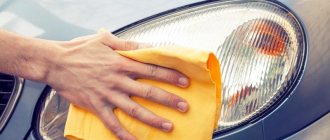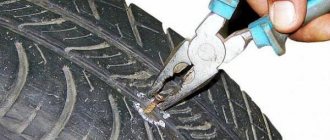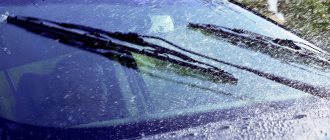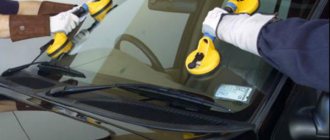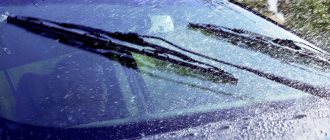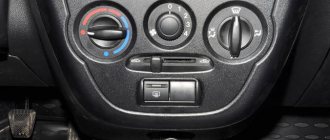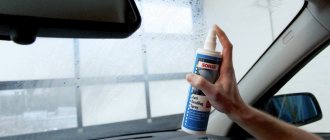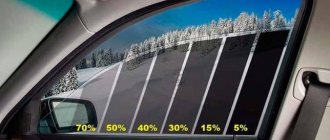Reading Time: 6 minute(s)
If you want to install a windshield or simply strengthen your windows, windshield adhesive is what you need. It is easy to apply and is not that expensive. However, there are many different products on the market now, which undoubtedly makes it difficult to choose. We have compiled a list of the 7 best products, where you will definitely find the car adhesive for auto glass repair that is suitable for you.
Not only that, you can find a lot more useful information in this article. For example, you will read about what automotive sealants are and you will be able to find out if you really need one.
Glue requirements
The car is constantly in motion, it is affected by temperature changes, vibration and adverse weather conditions, therefore the adhesive-sealant for gluing glass must have:
- resistance to temperature changes;
- good adhesion to various materials;
- high elasticity and lack of shrinkage;
- vibration resistance;
- moisture repellency;
- high drying speed;
- Possibility of application at any time of the year, even at low temperatures;
- environmental friendliness;
- durability;
- possibility of tinting (in some cases, a car requires not only gluing the glass, but also matching the color of the sealant to the color of the car body).
The polyurethane sealant-adhesive for gluing glass and replacing or repairing headlights is considered the most suitable among auto repairmen for these purposes. Among the many polyurethane sealants for replacing glass in a car, Teroson from Henkel is the most commonly used.
How to use adhesive sealant
A firmly fixed windshield is no less important for the safety of the driver and passenger than seat belts, airbags and other passive safety equipment, so the gluing of car glass must be carried out in compliance with all technologies. There are many polyurethane adhesives, so let’s look at the technology for the most popular Teroson adhesive-sealant from Henkel:
There are many polyurethane adhesives, so let’s look at the technology for the most popular Teroson adhesive-sealant from Henkel:
Preparation of material. Most adhesive sealants, including Teroson, require heating before application. To do this, tubes with glue are placed in a special heater. While the glue is heating up, you can remove the car windshield or carry out other preparatory work. Removing glass. To do this, on most cars it is necessary to remove additional decorative elements, and then, using a stretched wire or special knives, carefully cut the seam from the old sealant. After cutting the seam, the windshield or rear window is carefully removed. Surface cleaning. New glass in places where glue is applied is thoroughly cleaned. It is recommended to buy cleaners from the same company as the glue-sealant for glass. Body preparation. To do this, it is cleaned of dust, dirt and remnants of old sealant, and the damaged body coating is restored.
It is important to restore the paintwork before gluing the glass. All preparatory work is carried out before installing the glass. Applying glue
Windshield adhesive sealant is carefully applied either to the glass itself or to the car body. The choice of method does not affect the quality of the replacement and depends only on the preferences of the master. The glue is applied so that the glue bead is the same everywhere. Glass installation. This must be done immediately after uniformly applying the sealant, because it has a high hardening speed. If you install the glass after a short period of time, then due to the viscosity of the glue, it will not stick well, and the tightness of the joints will be broken. Polymerization of sealant. After the glass has been installed, it is necessary for the seams to polymerize, and during this time the car must remain motionless - 1 hour if the car does not have airbags, and 2 hours if there are airbags.
After this, you can use the car without restrictions, but in the next couple of hours it is not recommended to reach speeds above 60 km/h.
Headlight repair is carried out according to a more simplified scheme:
- The place where the sealant will be applied is cleared of contamination.
- After cleaning the dirt, the edges are treated with a cleaner.
- Glue is applied to the glass in an even layer.
- The headlight is glued into place immediately after applying sealant to the glass.
Just like when installing glass, you need to wait an hour after repairing the headlight. If you start driving right away, the vibration that occurs when the car is moving will disrupt the polymerization of the sealant, and the seam will be fragile; the headlight will soon require additional repairs.
If you choose the right glass adhesive, taking into account all the required characteristics, and use it as recommended by the manufacturers, then the installed windshield or rear glass will hold firmly for a long time.
Choosing adhesive for installing a windshield
The sealant for gluing glass is selected based on:
- shield size;
- room temperature;
- installer experience.
On average, one glass requires 300 g of composition. On cars with a large shield, it may take about 450-600 g. In this case, you should buy two tubes of glue. If the composition runs out and there is no other can at hand, you will have to go to the store. During this time, the sealant will crystallize and all preparatory operations will have to be repeated again.
The temperature at the work site affects the strength of the seams and the final tightness of the glass. The operating temperature of the glue is indicated on the label. It depends on the manufacturer and is within +5...20 °C. When working in winter, it is worth choosing a composition with the lowest temperature for crystallization.
The choice of glue based on the hardening parameter depends on the experience of the car owner. When replacing glass on your own, an inexperienced person has difficulty applying sealant, moving the shield, and centering it within the frame. Quick-drying materials will push the driver, which is why he may make a mistake or not have time to attach the glass to the frame at all.
Which composition to choose:
- Sika;
- 3M;
- Dow.
Popular manufacturers monitor product quality, conduct tests and refine formulations. When using low-quality glue, the glass may partially come off, greasy stains may appear, leakage during rain, and rust may occur on metal frames.
How to protect your windshield
To prevent chipping, there is a special film that is glued from the outside to the entire surface of the glass. It will protect against minor damage, but will not save you from major ones. And this film has a very significant drawback. It quickly rubs off with the windshield wiper blades. Our roads are not yet clean enough and the dirt on the cars leaves no doubt about this. It even leaves arc-shaped stains on the glass. What can we say about the film? There is only one recommendation: be careful when driving. Do not approach the car closely before overtaking, but begin the maneuver at a distance. On a gravel road, pass oncoming traffic by driving closer to your side. And stay away from trucks with rubble...
Varieties
When we are convinced of the very fact of the existence of miracle adhesives for glass, it remains to classify them by type. Depending on the composition, there are silicone, polyurethane, epoxy and polymer sealants. By the number of reagents - one- and two-component. There may also be adhesives for fastening and optical adhesives that restore the damaged area, masking the appearance of the flaw on the glass.
By purpose
Depending on their purpose, sealing adhesive compositions are divided into installation (for installing new glass) and repair. It is advisable to avoid attempts by salespeople and consultants to impose universal sealants.
The subtlety lies in the fact that the glass design provides not only visibility, but also the overall rigidity of the car, being an important part of the frame. Poorly repaired glass will not be able to perform this function.
Assembly composition for gluing
Such familiar, soft and elastic rubber bands that reliably fix the glass plane in the frame and absorb vibrations transmitted from the suspension are a thing of the past. Instead, a locally created layer of polyurethane or silicone-based sealant is used.
More often than others, craftsmen use sealant compositions such as DOW, 3M, Sika, Wurth, Teroson, and Eftec for gluing. A couple of hours will pass and the sealant will harden, securing the plane of the car glass, ensuring reliable contact with the body.
Optical or repair sealant
The next group of compounds is for repair or optical. Dealing with them is not difficult: you need to get rid of chips, seal the crack in the glass - choose an optical sealant. To form a bead of glass seam holding the window plane, you need another composition - an assembly one. These adhesives are not interchangeable because they perform different functions. Their sealant setting speed is not necessarily the same.
What is important for optical silicone is that after polymerization it will not become cloudy, will not lose transparency, and will not be noticeable. Otherwise, the repair loses its meaning, then it’s easier to change the glass
Repair technicians can use Henkel, 3M, Dow brand compounds, and sealants from other manufacturers.
By composition
The basis of modern miracle adhesives is polymers. Polyurethane, silicone, acrylic compounds, with ultraviolet stabilization - this is an approximate list of sealants offered by automakers. They also differ in different degrees of adhesion, depth of penetration into the glass, and curing time of the glue.
Balm
The main component of this glue is fir resin, resin. Suitable for gluing glass and fixing fragments together. The sealant has a slight yellowish tint.
Balsam
A variation of the previous composition, with a more pronounced yellowness of the frozen glassy mass. It features increased adhesion and reliability. Despite the quality characteristics of the sealant, glue is rarely used due to low transparency.
Balzamin-M
Modifier based on natural components with improved transparency. The composition retains the advantages of balsam: elasticity of the joint, work in a wide temperature range, light transmittance of the glue.
UV
To stabilize and set this composition, a source of ultraviolet radiation is required. After polymerization, the sealant is transparent, durable, and reliable.
Acrylic based
With the discovery of acrylic resins, they quickly found application in various fields, including car glass repair. There are no complaints about the characteristics of the resulting glue roller, with the exception of a slow, “thoughtful” setting. On average, acrylic sealants cure in 2-3 days.
Silicone
Viscous composition with a characteristic vinegar odor. Used in plumbing, construction, repairs. Also suitable for gluing glass. It sets quickly, the seam is moderately elastic, the glue does not lose its properties over time.
Polyurethane based
Polyurethane, rubber-like sealants are a serious competitor to silicone. They form a liquid-resistant, durable and elastic adhesive layer. They are not afraid of heat and cold and are comfortable to work with.
Polymeric
In terms of characteristics, polymer adhesives are close to silicones and polyurethanes, but after hardening, excess composition is difficult to remove without special solvents. Sealants are characterized by increased adhesion, are resistant to chemicals, and can be painted.
The best way to glue headlight glass: types of sealants
The market offers a fairly extensive range of compositions that differ in chemical properties, ease of use, and cost. What to choose? First you need to understand the classification. There are 4 types of sealants for headlights and car glass.
For better bonding, it is better to dismantle the headlight
Silicone
In terms of composition before polymerization, these are semi-liquid fluid products made from natural or artificial rubber. After application, the material hardens, turning into a kind of rubber that glues surfaces, protects from UV radiation and seals joints. But silicone products have a significant disadvantage - poor resistance to chemically aggressive environments, for example, technical oil, gasoline, diesel fuel, etc.
This is especially important if the car has a headlight washer system, which uses a special liquid that contributes to the process of destruction of the sealant, but sometimes oil-resistant products are found. In winter, it is also affected by anti-ice reagents
The main advantage of silicone compounds is their low cost and the ability not to lose their properties over a wide temperature range - up to +100°C. Ideal for mounting fog lamp lenses.
Polyurethane
These automotive sealants are very helpful in situations where you need to glue individual fragments of broken headlight glass or simply repair a chip or crack. The main advantage of polyurethane compounds is high adhesion (stickability) and good adhesive properties. Dried polyurethane based sealant is water resistant.
There are other advantages:
- The adhesive material can be used in a wide temperature range - from minus 60 to plus 80°C;
- service life reaches several years;
- the composition is resistant to the effects of motor oil, fuel, alcohol washer fluid and anti-ice agents;
- good fluidity before polymerization makes it possible to connect fragments of the most complex configuration;
- frost resistance;
- The glued structure reliably resists vibration.
Polyurethane sealant: everything is written on the package
What about the disadvantages? They are also available. The first is toxicity, which requires compliance with special safety rules: you need to work in rubber gloves, goggles, and sometimes a respirator (if the amount of work is large, for example, in a machine shop). And another disadvantage is poor resistance to high (more than +120°C) temperatures, which is typical for halogen lamps. However, the product is quite suitable for repairing mirrors.
Anaerobic
These compositions are characterized by high strength and resistance to high temperatures (up to +200°C). Sealants of this type are used for sealing joints and seams. Before polymerization, anaerobic sealants are in liquid form. Because of this, there are some inconveniences during use. But the chemical composition of the product is harmless to humans, and additional protection in the form of gloves and glasses is not required. The only requirement is to prevent the sealant from getting into your mouth and eyes.
Heat resistant (high temperature)
The main advantage of these sealants for headlights and car glass follows from their name. Compositions of this type can easily withstand temperatures up to +300 and even +400°C. That is, these heat sealants are well suited for working with headlight lenses that contain halogen lamps. The heat-resistant product is quite durable and is not afraid of vibration and mechanical impact. Heat-resistant sealants are produced in paste form or in two-component form. There is also a drawback to high-temperature auto sealant - a long hardening time, reaching up to 8-12 hours.
What are the dangers of a bad choice?
An unsuccessful or incorrect choice of sealant will lead to unpredictable results. This is a loss of transparency, unsatisfactory resistance of the seam to vibration, probable destruction under the influence of moisture or an aggressive environment.
Reduced glass transparency
The master, when choosing glue to seal the crack, made a slight mistake (or the customer decided to save money) by using balsam instead of a transparent polyurethane compound. The result will not be long in coming: drips, visible sagging and a difference in color between the main structure and the seam. And also wasted money, lack of the expected effect from glass repair.
The appearance of unsightly spots
One of the likely manifestations of an unsuccessful choice of glue. Spots may appear immediately after the start of polymerization, or a little later, during the operation of the glass. It is impossible to eliminate them, and this is the main problem with the sealant.
Increase in crack size
In the practice of craftsmen, it also happens that broken glass continues to collapse for a number of reasons: it expands (the crack lengthens), new chips appear. The fact is that in a car, windows are subject to the same dynamic loads as the rest of the frame elements. If the integrity of the glass is not restored and securely fixed in the opening, then irreversible processes will continue until it completely bursts or falls out.
Rules for gluing the windshield
The whole procedure fits into several interconnected stages. The final result depends on consistency and accuracy. So this is:
- Removing old glass. At the same time, seals and decorative inserts are removed. A sharp knife or piece of wire is used and inserted into the seam.
- Next, the contact areas of the new window panel and the corresponding body components are cleaned. If damage to the paint layer is detected, they are restored.
- If according to technology the adhesive is applied at a certain temperature, this condition must be met.
- All that remains is to carefully distribute the glue (create a bead) on the glass or in the body recess, and then glue the glass to the composition.
Removing old sealant
The old seal is removed mechanically using a sharp knife. Then the surfaces are cleaned of dust, dirt, degreased, and prepared for glass installation
It is very important that no fragments remain, otherwise obtaining a high-quality adhesive seam is not guaranteed.
How long does it take to dry?
The setting time of the adhesive depends on the specific brand of the composition, the design of the car (with or without cushions), layer thickness, and temperature. With modern polyurethane sealants, the average polymerization time is 10-15 minutes, and the adhesive gains strength within an hour. For comparison: acrylic mixtures take up to 3 days to dry.
Preparing the place for gluing the windshield
The body at the place where the triplex is attached must be cleaned of old glue residues. The same should be done with the removed windshield if it was removed to fix a leak. Cleaning is done with a chisel, while the adhesive-sealant can be softened with a solvent.
A layer of primer primer should be applied to the cleaned surface using a brush or swab. The same primer should be applied along the edges of the glass in places where it adheres to the body. The presence of soil improves the adhesion of the polymer to the materials.
Before installation, the windshield should be fitted to the opening. If the design of the car does not provide special stops, it is necessary to make marks with a marker.
Terms of use
It is important to apply any sealant at positive air temperatures; most manufacturers advise that the temperature be above +5 degrees, or better yet, above +15 degrees. After application, the car must not be moved for approximately 2-3 hours.
Before you begin, it is important to wear rubber gloves and safety glasses.
Sometimes old sealant is quite difficult to remove. First, it can be heated with a hair dryer, due to which the old product will soften and be easier to remove from the surface of the car.
Remains of the substance can be removed with a regular knife, but it is important to cut off the sealant carefully so as not to leave scratches on the car body. To dissolve the remaining sealant, use a solvent or solarium. It is necessary to adhere to the following sequence of actions when gluing glass:
It is necessary to adhere to the following sequence of actions when gluing glass:
The old seal does not need to be completely removed, but cut with a sharp knife to a thickness of about 2 millimeters; if required by the instructions, the substance must first be heated before application; the sealing compound is applied using a pneumatic or mechanical gun in a uniform layer without breaks; After gluing the glass, it is important to secure it with ordinary masking tape; The side windows of the car are lowered to dry and ventilate the car.
It is important to remember that any sealant can only be applied to a surface that has been previously cleaned of dust, dirt, debris, grease stains and other contaminants. The surface must be degreased using a solvent.
Do not slam car doors until the composition has completely hardened. After gluing the glass, it is not recommended to drive the car for the first 48 hours.
Varieties and features
The main task of sealants is to eliminate leaks and cracks. With their help, it is possible to cope with punctures and gaps. There are many such products on sale. However, you should be very careful when purchasing them. To buy a quality substance, it is recommended to familiarize yourself with its characteristics and composition.
Anaerobic
Such sealants are special compounds containing dimethacrylate esters. They are characterized by the possibility of polymerization without an influx of oxygen. Substances acquire a solid consistency when in contact with metal in narrow places where air does not penetrate. If these conditions are violated, the product will remain in liquid form.
To achieve polymerization of the composition, it is necessary to firmly connect the elements of the parts. This will help get rid of oxygen. When it enters a metal gap, the substance hardens within half an hour, becoming a solid polymer.
Silicone
For independent use, you should use silicone sealant. The composition has excellent elasticity and provides high strength. Such substances differ in elasticity parameters and temperature. Sealants polymerize due to moisture present in the air.
Polyurethane
This sealant promotes bonding of different structures. The substance is characterized by excellent adhesion. It is produced in different colors. This helps to choose the appropriate composition.
For exhaust system repair
This system is susceptible to elevated temperatures. The maximum load falls on the muffler. Under the influence of negative factors, the elements of the system are destroyed and burned out.
To repair the exhaust system, you should use a heat-resistant sealant. Its use will help prevent pipes and clamps from sticking to each other. In this case, the sealing of the connections will be as reliable as possible. Compositions in the form of cement, glue or paste can be used for rounded elements of the exhaust system.
Acrylic
Such sealants are a mixture of acrylate polymers that are used for interior work. They are often coated with acrylic paints or varnishes. Due to this, it is possible to obtain different shades. Such compositions are either waterproof or non-waterproof.
Bitumen mixtures
This term refers to a paste-like substance that is made on the basis of a modified material with the addition of fillers. Thanks to this, the product becomes resistant to negative factors.
Ceramic
Such products are made on the basis of synthetic components using ceramic components. Due to this, it is possible to increase the strength and resistance of the material to high temperatures.
For glasses and headlights
When choosing a sealant, you should focus on the recommendations given in the service book
The material from which the headlights are made is also important. Glass or polycarbonate is used for this.
Many compounds are prohibited from being used to repair polycarbonate, as they lead to its destruction. The shade of the glue does not affect its properties.
Chip repair
In a repair shop, a thin drill with a cutter at the end goes through the chipped area, trying not to go deep into the film between the triplex glasses. The hole makes it easier for glue to fill cavities. Using an injector, pressure and vacuum are created for high-quality flow of the polymer. Then polymerization or drying occurs under the lamp. The remaining glue is cut off with a special soft blade so as not to scratch the glass.
The glass being repaired dries for as long as it takes for each type of damage. If the chip is small, then ten minutes is enough, but for complex repairs, the glue drying time can take up to half an hour.
It is necessary to seal the damaged area with transparent tape on the outside. This will not give dirt access, and will slightly delay the visit to the master. And if the chip is closer than 15 centimeters from the edge, then you need to look for the nearest repair service. Otherwise, it will develop into a crack due to the stresses of the glued glass resulting from the torsion of the body.
Types of adhesive for car glass
It is possible to correct the defect without resorting to the services of a car repair shop for glass replacement. You can seal a crack in your windshield with your own hands. For this, organic resins and synthetic polymer components are used.
Auto repair adhesive is used: to secure and mount the entire front glass or to repair chips and cracks on it. In the first case, a flexible connection is created, which makes it possible to compensate for deformation vibrations. The composition must meet the following requirements:
- Heat and moisture resistance.
- Create an airtight coating.
- Form a seam that is resistant to prolonged vibration and aggressive environments (windshield wipers, icing, intense pollution).
- Average setting speed.
- Low viscosity (to penetrate micro-chips).
- Transparency.
The following compounds are suitable for eliminating cracks and chips:
- Glass balm: “Canada balsam”. It is a solid transparent material that consists of organic resin. Firmly holds the fragments together and does not crystallize. Heating is required to use it. Time until complete drying is 48 hours.
- Silicone adhesive: Done Deal DD6705. A synthetic composition that has high adhesive properties. Has a wide operating temperature range. Provides reliable fastening of materials.
- Acrylic glue: Master Teks. Suitable for repairing cracks and sealing chips. Creates a flexible layer after drying.
- Ultraviolet adhesive: UV SM 510. The connection is not damaged even if the glass breaks. Exposure to a UV lamp is required for activation and setting.
If it is not possible to immediately seal the damage, use tape. This will prevent the schism from spreading further for some time.
Main types of adhesive for auto glass
Adhesives for car glass repair are available in a very wide range on modern consumables markets. You can find a suitable composition that can quickly eliminate a defect on the glass.
Among the main types:
- Glass balm - this substance can be found on sale in the form of a glassy mass. It contains fir resin - an organic component that allows even small fragments to be firmly held together and is distinguished by its ability to dry quickly.
- Balsam for auto glass is presented in the form of a yellow liquid and has many advantages. Among them are resistance to elevated temperatures and strength. But due to the characteristic shade, this product also has a drawback - a yellow spot may appear on the surface of the glass after eliminating the defect.
- Balsam M is an improved version of the previous variety of balsam, which has even greater strength and a transparent consistency. That is, after the substance dries, there are no stains or streaks left, since the glue is transparent. The main advantage of this product is that after drying and hardening it does not deform.
- Ultraviolet glass adhesive is one of the modern developments. It allows you to work with defects and cracks of any size, allowing you to eliminate them efficiently and quickly. In order for the result to be of the highest quality, it is necessary to expose the damaged area to ultraviolet rays.
- Acrylic glue is suitable for novice craftsmen or vehicle owners who can carry out repairs themselves. It has good viscosity, which makes it easy to work with. But in order for the glue to completely harden on the surface, at least 72 hours must pass.
Note! Many inexperienced drivers who decide to get rid of car glass cracks on their own purchase standard contact superglue. But there will be no benefit from using such a remedy. After drying, the glue will make the area of the car where the defect was cloudy and opaque, and many unattractive spots will appear on the surface. Also, while the car is moving and exposed to vibration, the crack will further increase in size.
Which sealant is better
When choosing a product, you should pay attention not only to its parameters, but also to the brand’s popularity: it is not recommended to buy the cheapest, untested formulations
SikaTack Drive
A distinctive characteristic of the sealant is its suitability for any glass of trucks and cars. The product is available in 310 ml tubes, used without preheating at temperatures of about +20...+22 degrees, hardens in 4 hours.
3M Windo Weld SuperFast Urethane
The sealant does not require the use of a primer, since it itself is quite durable and is not afraid of ultraviolet radiation. It can even be used on the windows of racing cars and vehicles that are often driven off-road. After application, the product begins to set in 15 minutes, complete crystallization occurs in 8 hours.
Dow Automotive Betaseal 1527
The set of accessories for making a sealing seam includes a primer - it is mandatory for use with this composition. The product has the following properties:
- low electrical conductivity;
- initial setting in 12 minutes;
- highest strength;
- suitability for all types of transport;
- Possibility of application at +5 degrees and above.
After gluing the glass, you can use the machine within an hour (in emergency situations), so the product is considered one of the fastest-drying glass adhesives.
Dow Corning 7091
This silicone-based composition is widely used when replacing glass, since it has excellent adhesion to metal and plastic, is characterized by high elasticity, strength, and works at –55...+185 degrees. Typically, white sealant is used for glass installation, although black and gray products are also available for sale.
The composition of this brand is available in a standard 310 ml tube, as well as in 20 liter and 250 kg cans (for industrial use). It hardens in 3 hours and does not require priming or heating during application.
3M PU 590
The product is considered universal, suitable for working with a variety of surfaces - glass, metal, wood, plastics. It sets in 25 minutes, dries completely in 4-8 hours, and does not require the use of a primer. The disadvantages include the risk of cracks and crumbling when heated above +100 degrees.
Abro WS 904
A sealant under this name is highly valued by professionals and is considered one of the leaders on the market. Sold in the form of a rolled tape, it is easy to use, does not stick to your hands, and has a high degree of adhesion and plasticity.
Donedeal DD6870
The product has a high degree of transparency, is invisible on glass, and can be used to repair other parts of the car. The characteristics of the sealant are as follows:
- temperature during operation - from +5 to +30 degrees, temperature range during operation -45...+105 degrees;
- connection strength - 195 kg/sq. cm;
- initial setting time - 1 hour, period until complete polymerization - 24 hours.
The sealant is well suited for gluing materials with different coefficients of thermal expansion - plastic, glass, plexiglass, rubber, metal. It does not deteriorate from vibration, mechanical stress and the action of chemicals.
"Efimastica RV"
A one-component polyurethane sealant is used in conjunction with the primer that comes with the kit. It forms a very strong connection between glass and metal, plastic, and completely hardens within 24 hours, although it forms the initial film in 30 minutes. The seam can be used at temperatures from –40 to +80 degrees and has high tensile strength (6 MPa).
Teroson PU 8590
This sealant is also prepared on the basis of polyurethane and is widely used for gluing auto glass not only in passenger cars, but also in trucks, buses, and railway cars. Requires prior application of primer. It sets in half an hour, dries in 4-6 hours. It is UV resistant, wear-resistant, and holds the glass securely immediately after insertion.
Merbenit SK212
The product based on modern MS polymers boasts the highest tensile strength and is even used in shipbuilding. The sealant does not need a primer or heating, it is resistant to vibration, loads, ultraviolet radiation, protects the metal from corrosion, and can be painted even in a semi-hardened form.
Liqui Moly Liqui Fast 1400
Polyurethane sealant of this brand is used for gluing any car glass; it cures in a short time under the influence of moisture. It has good elasticity, elasticity and strength.
Rating
Seal-ALL Adhesive
Seal-ALL is also not much different from other sealants. It's not bad, of course! They are similar because almost all products from well-known manufacturers have good characteristics.
Seal-ALL is a very strong adhesive. It can “live” for a long time, even in the most extreme conditions, the glue is also waterproof, resistant to abrasion, gas and oils.
It dries quickly and becomes transparent, making it invisible to the eye.
Plus, it's an ideal solution if you're in a hurry, Seal-ALL can dry in 2-3 minutes. So, if you're on the road and notice a leak, you can take immediate action. This sealant will do the job perfectly. However, the silicone remains sticky for a while after drying, which is a bit of a shame. The sealant takes about 2 or 3 hours to cure, and after 10-15 hours it will be completely cured.
Seal-All is also versatile. Basically, it can be used for any type of car repair, not just windows and windshields.
Permatex
It is durable, can withstand extreme temperatures and is completely waterproof. In addition, Permatex car glass adhesive can also withstand strong chemicals.
Permatex is very easy to use and its flow feature only adds to its benefits. Its fluidity allows it to penetrate every crevice, no matter how small. And once it gets there, it becomes almost impossible to get hold of! This feature also gives you a smooth surface when dry, without any "scratches" or dents. Permatex is completely transparent, even after it dries.
When it comes to drying time, this sealer performs great again, taking 30 minutes to dry and you're good to go. It's not the fastest drying time, but it's not the worst either.
Another thing I really like about caulk is that it is so versatile. Yes, it works great on windshields and car windows, but it can also be used on sunroofs, headlights, and more. If you're looking to save money, this sealant is definitely the one for you.
Its flaws are minor to be honest, but I'll tell you about them anyway. The sealant has a chemical smell that some people may find very unpleasant. A second coat may also be needed. But the fact that it only takes 30 minutes to dry is not so bad.
Versachem Windshield and Glass Sealant
This windshield glue can be used for glass, metal, rubber, wood, plastic and so on. Overall, this is a strong and reliable adhesive that can be used on windshields as well as any other car parts.
Versachem is waterproof and can withstand extreme temperatures, high pressure and strong chemicals. The application process will not make you “sweat”. Just squeeze the tube and that's it. Like Permatex, Versachem also has a "flow" feature which also makes it easy to apply. It can reach even the most difficult to reach places and fill every hole it comes across.
Drying time is quite fast - about an hour. After an hour has passed, it will seal and protect your windshield from leaks. However, it takes about 24 hours to dry completely.
Dow U-428
Dow U-428 is the most expensive product on our list. But don't get me wrong, it is still available to many buyers! Its price is a little higher because it offers much more than the average sealant.
This is not just a regular solution that you squeeze out of a tube. It requires a lot more work, but the results are amazing. U-428 is very rigid and durable, so it is mainly used for glass bonding.
This sealant does not require a primer, it is a one-part adhesive. Although this application process can be quite complex. The consistency of this sealant is very thick, so it cannot be squeezed out. You will need to warm it up before applying. The best way to do this is to use some kind of heat gun.
Gorilla multifunctional sealant
Gorilla is a well-known brand name, and for good reason.
Unlike some other sealants that also act as an adhesive, Gorilla is made from pure silicone. It's not as durable as other products on our list, but it does a great job of filling cracks. Silicone is very elastic, so it can take any shape.
In addition, silicone also makes this car windshield adhesive tough and durable. Can withstand extreme conditions and, of course, water.
When it comes to drying, the Gorilla dries and becomes completely transparent. It takes about 30 minutes to dry to a tacky state where you can expose it to water or rain. And in a couple of hours it will dry completely. Once this happens, it becomes incredibly hard.
Boll 310ml.
BOLL adhesive is a one-component polyurethane adhesive that cures very quickly with moisture in the air, creating an elastomer with very good mechanical properties. It is resistant to water, weather and acids.
Due to its good adhesion, elasticity and durability, it is used for gluing windshields and rear windows in cars. The resulting seal withstands large temperature fluctuations. Can be used in vehicles with an airbag system. The car will be in working condition after 3 hours (at 23 degrees Celsius and 50% humidity).
TITAN P2G
Believe me, this glue was called Titan, absolutely deservedly so! The glue is made of polyurethane, which makes it very durable. It can be used to replace a car's windshield, but it will also fix windshield leaks. Avoid alcohol-based solvents when applying Titan.
The adhesive does not require mixing or priming, you just need to apply it at room temperature. Just like everything else, it dries quite quickly. However, when it comes to actual application, this is not so easy to do. The tube requires strong compression and good patience.
Overall, Titan will successfully seal your windshield, but the adhesive is designed to do much more. If you are looking for a product that will not only fix a small leak, but can also help you replace glass parts on your vehicle, Titan is definitely the one for you.
Types of body sealants by application method
Today there are many types of sealants, which differ in the method of application.
Sprayable moisture-curing
Typically such agents include modern polymers. The compositions are made one-component. The substances contain many dry components, so they dry quickly in the air under the influence of humidity. As a result, a strong seam is formed. A special gun is used to apply spray sealants.
With brush application
Such products are made from silicone and nitro resin. Onnies are used for sealing seams, fixing lintels, pallets, sealing trunks and wheel arches. The compositions are produced in white, gray or black. It is recommended to apply them with a brush. Drying occurs in 10 minutes.
Sealant tape
Applying a substance to a car often requires special skills. Otherwise, it will not be possible to make the seam strong. If there is no dexterity, use tape. This sealant does not require the application of glue. The material is flexible, which helps make repairs in different places. Immediately after fixing, the tape can be painted. There is no need to dry it.
Extruded
Such substances are sold in tubes or cartridges. To seal seams and joints, it is recommended to squeeze the substance out manually or use a gun. When using a pneumatic gun, you will be able to obtain a uniform seam. Such compounds are suitable for hood seams.
How to glue a windshield using sealant - technology
Stage 1 – cutting the windshield
The work must be done by two people. The first thing to do is to push a layer of polyurethane glue between the glass and the body. This will allow you to quickly and easily cut glass using a string. We pierce the glue with an awl with a threaded string, the awl goes through the glue. Using pliers, pry the string from the back side so that it goes right through, and then pull the awl back out. As a result, one end of the string remained inside the cabin, and the other outside.
We attach the string to the handle by which we will pull it.
Stage 2 – glass cutting
It is important not to scratch the dashboard and plastic elements of the car body during cutting. The string works like a knife
We carefully pull the string along the glass; an assistant helps pull the string while in the cabin. In the corner we put the string up and continue cutting along the side of the glass, then move to the top and return to the starting point.
We take out the cut glass and remove the remaining glue, leaving about 1 mm. This is how we prepare the area for applying new glue.
Stage 3 – glass preparation
We fix special Velcro on the left side of the windshield, using which we will lift and move it. To make the Velcro stick tighter, lubricate the back side with greasy soap. We repeat the procedure on the right side of the glass.
Apply masking tape near the gluing area. Clean the area with solvent.
Stage 3 - applying glue
To apply glue, we use a special gun for working with adhesives in foil film. It is best to purchase a pneumatic model. The convenience of such a gun lies in the simplicity and reliability of the design and ease of application of the composition. To fire the gun, you simply pull the trigger. Using this device, you can carefully apply glue in an even, continuous layer around the entire perimeter of the glass.
If we use Simp Seal 65 glue, we cut the tube spout with a knife. This is necessary so that the glue forms a “triangle”. Then we make a cut in the foil with glue and insert the package into the air gun. We install the notched spout and tighten the gun nut. Now you can start applying glue. Carefully squeeze it out of the gun and move along the entire perimeter of the glass. To make it convenient to work, the glass can be placed on the hood of the car.
Applying sealant and fixing the windshield
Stage 4 - glass installation
We lift the glass using the Velcro and install it back into the car. We secure it on top with additional tape to prevent it from slipping. We leave the car to stand for the glue to polymerize for at least 1-3 hours. Then the car can be rolled out to the parking lot and left for some time. The car can be used the next day.
VIDEO INSTRUCTION
Rules for choosing glue for glass repair
Windshields are glued with glue that can provide a high level of strength and the lowest ductility. Also, do not forget about such parameters as transparency, penetrating qualities, resistance to aggressive external environments (ultraviolet, frost, vibration).
Attention! To install the windshield yourself, use high-density glue. To obtain the best installation result, it is recommended to use a special gun (mechanical or pneumatic).
Specialists glued with various types of sealant - this is due to the rapid development of the market in this area. By the way, if the glued windshield was mounted using a composition based on balsam or balsam M, then light streaks may remain, visible to the naked eye.
How to change glass
Brief instructions will help you understand the basic process of replacing a windshield on any car; they are almost the same.
Tool
- Suction cups for the wind stack - 2 pcs.
- Glue sealant and syringe gun for application.
- Stationery knife.
- Degreaser.
- Help from a second person.
How to change
By following simple steps, you can complete such a seemingly difficult task as replacing a windshield. After preparing everything you need, get to work.
- The first thing you need to do is remove all the decorative elements (windshield wipers, plastic hood grilles).
- We remove the moldings (rubber between the glass and metal of the body).
- We remove the plastic linings from inside the cabin (side linings).
- Next, you will need a special tool - a string (a metal thread similar to a guitar string). It must be passed between the glass and the car body. This is done using another tool - an awl (visually similar to a knife with a notch for a string).
- Now the string (which has handles on each side) needs to go through the entire perimeter of the glass. It looks like a “cut” in glue. This job requires two people. One in the cabin and the other outside.
- After cutting through the old sealant, the windshield can be safely removed.
- Remove the old sealant using a utility knife.
- We put the molding on the new glass before installation.
- We degrease the car body and glass. Those places where we will apply glue. If the glue comes with an “activator”, it must be applied to the surface of the glass in a thin and even layer. The drying time of the sealant activator is 1-2 minutes.
- Apply adhesive sealant to the degreased surface. It is applied using a special tool - a syringe. The layer should be even, high but thin. This will ensure maximum sealing and glue protrusion beyond the edges of the body edge. Most often, adhesive-sealant is applied to glass, but sometimes it is applied to the body of a car.
- We apply the glass to the car body. Responsible action. The glass should fit neatly into place. For convenience, it is better to use glass suction cups.
- Lightly press the attached glass with the palm of your hand in the gluing areas (so that it fits clearly into the required grooves).
- In reverse order, we begin assembling the decorative elements that we removed at the beginning.
Materials and tools for windshield replacement
Before you start replacing your windshield, you need to stock up on the following materials and tools:
- metal string with 2 handles;
- awl or sharpened wire;
- suction cups for holding glass;
- screwdrivers;
- spanners;
- chisel;
- masking tape;
- glue-sealant for glass;
- gun for applying sealant;
- solvent, primer;
- tampons and gloves.
To replace glass, you will need a closed and dry room (garage or car bay). The car must spend at least one day in it.
To do the job efficiently and safely, you will need one or two assistants. Before starting work, the car should be washed (how to properly wash a car), especially in the area of the windshield.
Types of automotive glue
The composition used for gluing windshields is called adhesive sealant. For application, a special tool is used - a manual or electric sealant gun, since the force must be applied above average.
Replacement may require rear view mirror adhesive if the new glass was not equipped with fasteners. Then the fastening is separated from the removed window and, using glue, which is also called “mirror”, re-glued onto a new one.
And if you ask the salesperson at a car dealership the question “How to glue the mirror?”, then you need to clarify which one. Because the side mirror can be attached using sealant glue, and the inner one only with special glue for mirrors.
Glass repair glue is also called polymer. Its composition allows it to harden under ultraviolet irradiation.

